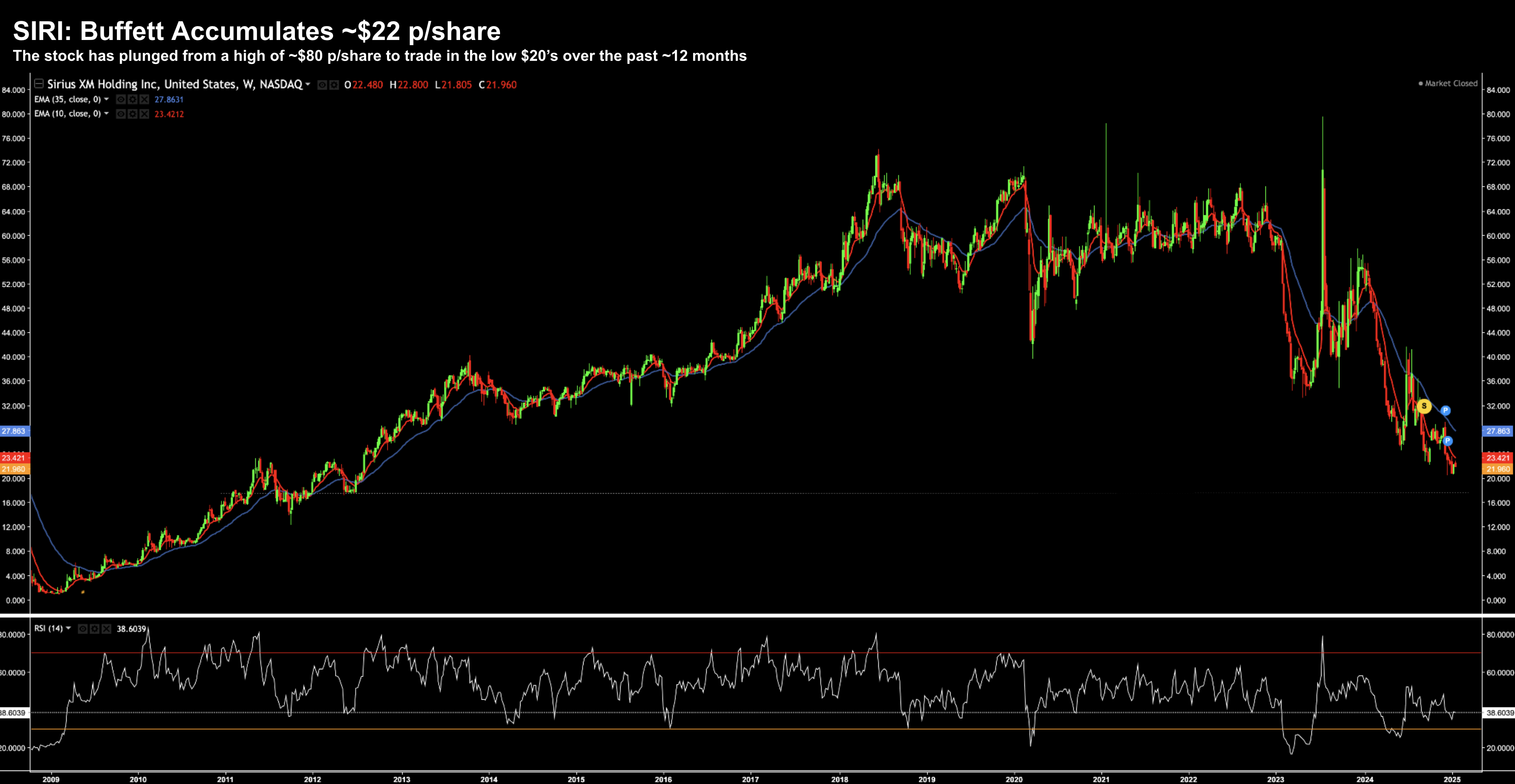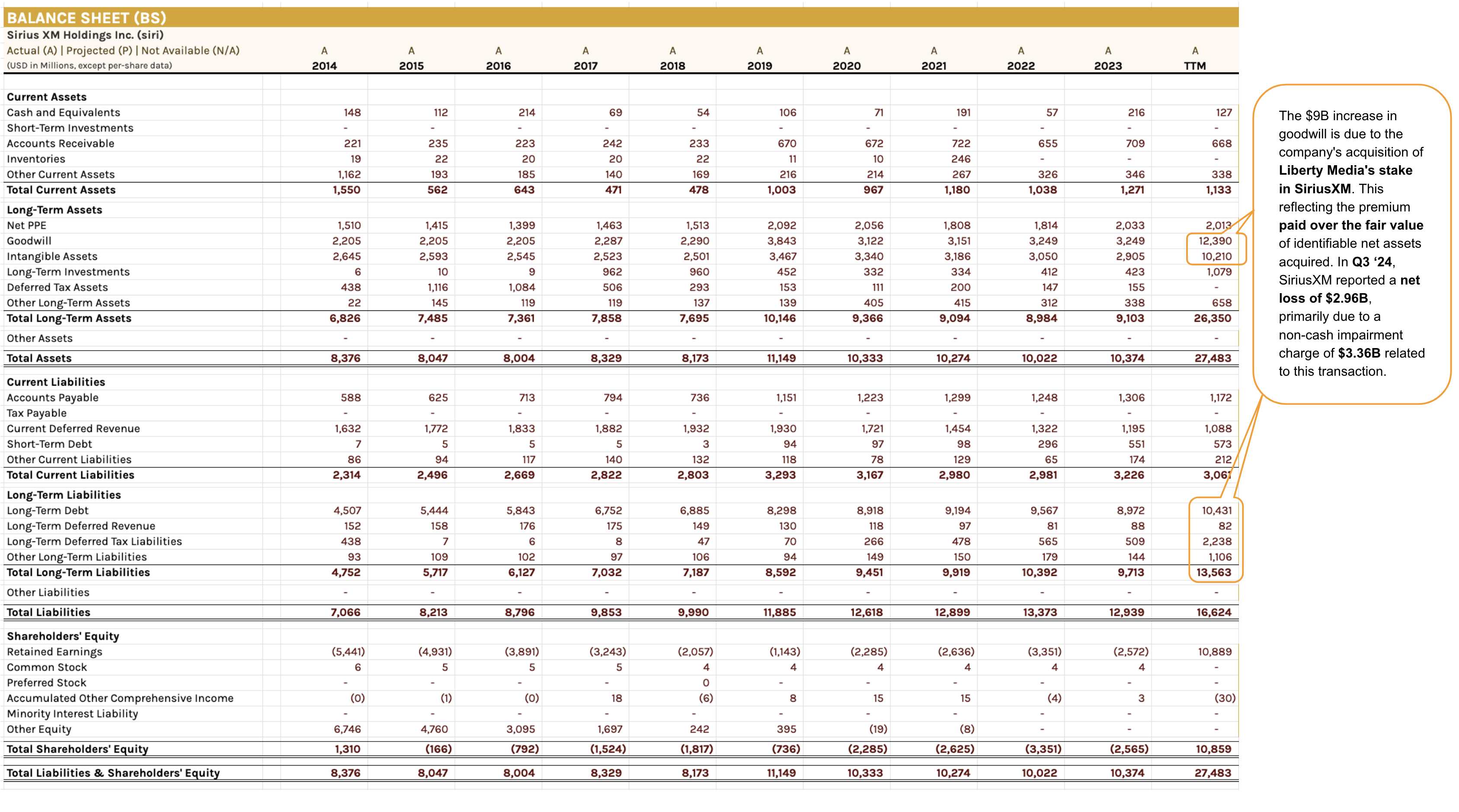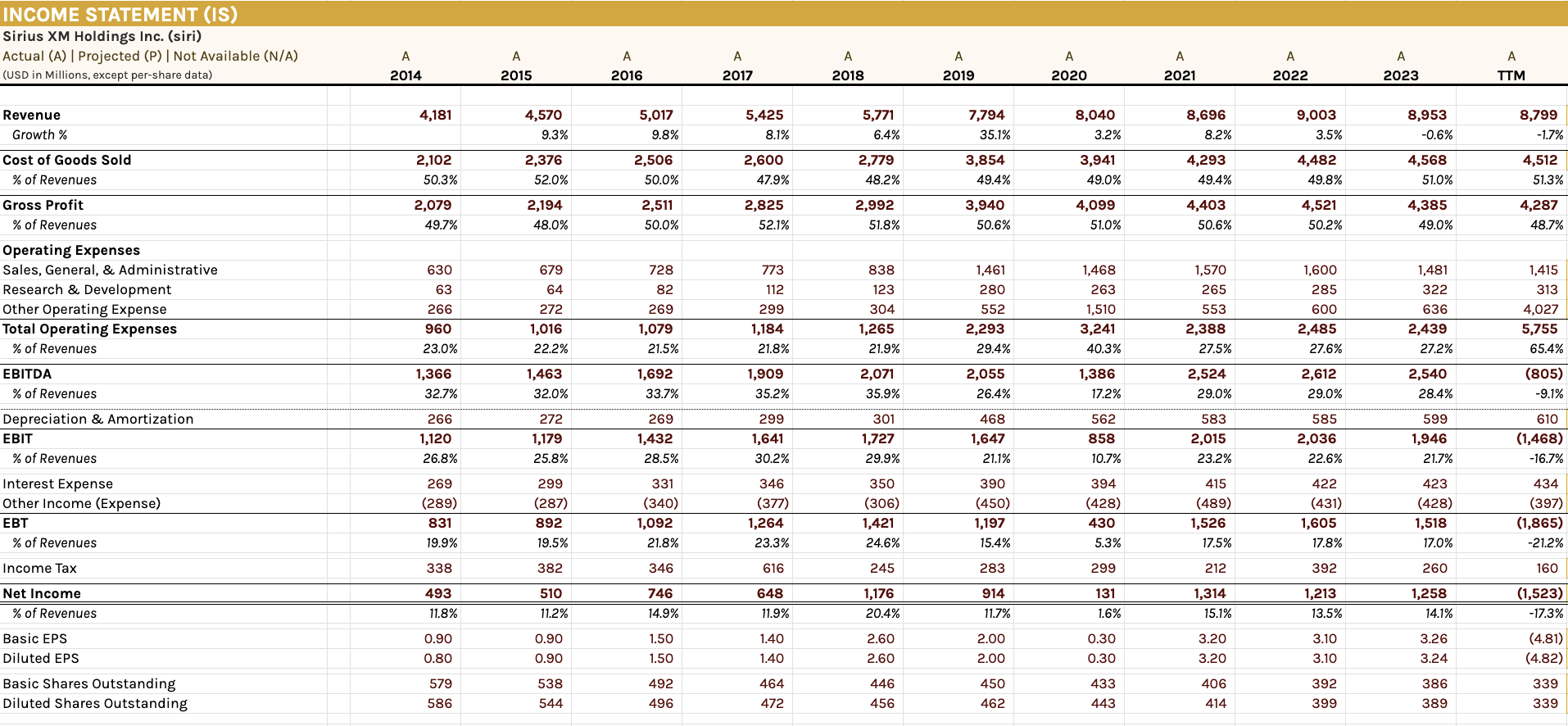Words: 2,041 Time: 9 Minutes
- Is SiriusXM (SIRI) a classic value-trap?
- Why Buffett sees limited (long-term) downside at ~$22; and
- Key metrics which suggest its (potentially) undervalued
Yesterday I offered readers a framework to evaluate the quality of a stock and whether it represented value.
In short, it leverages the work of other value investors such as Warren Buffett.
Buffett places significant emphasis on both Free Cash Flow (FCF) and Return on Invested Capital (ROIC) when analyzing businesses for potential investment.
Put another way, he is not governed by things like revenue and earnings growth.
He wants to see a sustained return on invested capital; however he is only willing to pay a “fair price” (or discount if he can get it)
Here’s how these metrics align with his philosophy:
With respect to FCF – Buffett will often talk to a concept of owner earnings – which is very similar to free cash flow.
He defines owner earnings as the cash flow available to shareholders after necessary reinvestment in the business.
This aligns with FCF because it represents the cash a company generates that can be freely distributed or reinvested. In short, it also demonstrates:
- the company’s ability to generate real cash that owners can use;
- where a company has greater flexibility for reinvestments, acquisitions, dividends, or share buybacks; and finally
- ensures that earnings are not just “paper profits” but translate into tangible wealth creation.
In terms of ROIC – whilst you may not hear Buffett use the term explicitly in his newsletters – his focus on businesses with durable competitive advantages (economic moats) naturally favors companies with high ROIC.
He prefers businesses that can generate exceptional returns on the capital they reinvest for three reasons:
- High ROIC (e.g. above 15% for at least 10 years) indicates efficient use of shareholder capital.
- Companies with strong ROIC often have sustainable competitive advantages, such as pricing power, brand strength, or cost leadership.
- A consistent and high ROIC ensures the company adds value for shareholders.
For example, you will often hear the 94-year old highlight exceptional businesses reinvest at high returns, compounding their growth over time.
As part of this post – I shared this table for his Top 5 holdings:
| 10-Yr Avg ROIC % | 10-Yr Av ROE % | |
| Apple (AAPL) | 39.1% | 85.9% |
| American Express (AXP) | 11.3% | 17.3% |
| Bank of America (BAC) | 10.7% | 8.1% |
| Cola-Cola (KO) | 11.8% | 31.4% |
| Chevron (CVX) | 4.2% | 6.4% |
Note: CVX was significantly impaired by COVID (where the oil price went negative) – however it’s most recent full year showed an ROIC of 17%
What’s key is each of these businesses can grow without needing to rely on outside funding (equity or debt).
Now very recently, Buffett may have surprised some people with a meaningful additional to his existing SiriusXM (SIRI) holding.
Many might think this stock is classic value-trap… with SIRI’s model being cannibalized by phone streaming services such as “Spotify” and others.
And that is true…
However, it’s also true that SIRI has 60% of the in-car ‘fixed audio’ hardware market with partnerships with many car manufacturers.
And whilst subscriptions have been falling – they are looking to change their pathway to market via:
- Different content bundles (i.e. cheaper plans)
- A new ad supported (free) tier;
- Exclusive content offerings; and
- Additional functionality (ability to save music to a playlist)
Analyzing Buffett’s SIRI Addition
For those less familiar, Sirius XM Holdings Inc (SIRI) provides satellite radio services on a subscription fee basis in the United States.
It broadcasts music, sports, entertainment, comedy, talk, news, traffic, and weather channels.
The company also provides streaming service that includes a range of music and non-music channels, and podcasts, as well as channels that are not available on its satellite radio service; and offers applications to allow consumers to access its streaming service on smartphones, tablets, computers, home devices, and other consumer electronic equipment, as well as connected vehicle services.
In addition, it distributes satellite radios through automakers and retailers, as well as its website.
Further, the company provides location-based services through two-way wireless connectivity, including safety, security, convenience, remote vehicles diagnostic, maintenance and data, and stolen or parked vehicle locator services.
Berkshire now owns about 33.2% of SIRI – as Buffett continued to buy the stock as the price went lower.
However, during the course of last year – SIRI continued to shed subscribers, revenue, and profit, culminating in the announcement of a “refocusing” of the business in early December
January 26 2025
And whilst its expectations for growth are lower – they are refocusing on their “core” automotive customer, with an additional $200M in cost cuts.
The challenges for Sirius are obvious and not insignificant:
- Most consumers today receive their music (and other content) via services like Apple Music, YouTube Premium or Spotify
- Consumers are increasingly price sensitive – reducing the number of subscriptions they have (i.e., no need for car-based content subscription plan)
- Marketing outside the US is proving to be difficult
- Content offerings will be reduced into different category blocks. Their content packages will consist of a music-only tier for $8 p/month, then news and talk each available for $5 p/month, and a sports tier for $8 p/month
2. Similar to Netflix – they will support a new free tier with ads. This is only available in vehicles with certain technology capabilities, and it won’t be available on the Sirius XM app. However, this will roll out as in-car audio tech is upgraded
3. They plan to enhance its premium tier – something they call an “Interactive Premium” bundle. For example, you can save songs to a customized playlist (emulating services like Spotify).
Of these three initiatives – the free tier with ads is the one I believe will be most successful.
It’s not unlike what traditional radio has been doing for years (and linear TV)
Besides, people love “free” content. It’s also why Netflix pivoted to this model.
What’s more, programmatic digital advertising tools help publishers attract higher ad prices through more precise targeting.
As an aside, Netflix is rapidly attracting new subscribers to its ad-supported tier – which tells me this could be a pathway forward.
However, it’s not without risks as they average revenue per subscriber (ARPU) are likely to fall.
Let’s now look at the quality and valuation metrics (and what Buffett may see)
Quality Metrics
Before we get to its valuation – let’s look at its quality over the past ten years.
Below is a screenshot from my personal dashboard (which pulls from the past 10-years of SIRI’s balance sheets, income statements and cash flow statements)

Growth / Profitability / Effectiveness Observations
- 10-year Return of Invested Capital (ROIC) has been strong – over 21%
- Profitability strong – with 10-year Net Income Margin (NIM) at 12.7% – above the market average.
- Operating Cash Flow Margin (OCFM) at 26.6% is very high
OCFM is a metric I rank – it tells me the true strength of a company’s operations and its ability to sustain long-term growth.
Each of these metrics will have caught Buffetts eye – notably its ROIC and NIM. He is far less focused on revenue growth.
Capital Structure & Debt, Interest Coverage and Liquidity Observations
- Up until 2023 – a Debt to Equity (D/E) ratio of -371.3% (where liabilities exceed total assets) is troubling.
- However, if we look at TTM (Trailing Twelve Months), the company saw a $9B increase in goodwill – due to the acquisition of Liberty Media’s stake.
- Note: goodwill represents the intangible value arising from such acquisitions, often encompassing factors like brand reputation, customer relationships, and expected synergies.
- In Q3 2024, they reported a net loss of $2.96B, primarily due to a non-cash impairment charge of approximately $3.36B related to this transaction.
Source: Personal Spreadsheets
- It’s important to note that while the impairment charge affects net income, it does not impact the company’s cash flow, ongoing operations, or liquidity.
- They have a very strong EBITDA ICR ratio of 6.0x – meaning EBITDA can cover its interest expenses six times over
Two things wrt short-term liquidity bear watching (however do not represent a significant risk)
- Current Ratio (CR) of 0.4x – which means they have $0.40 in current assets for every $1.00 in current liabilities; and
- Operating Cash Flow Ratio (OCFR) of 0.6 could raise concerns (i.e., they generate $0.60 in operating cash flow for every $1.00 of current liabilities)
In summary – over the past 10 years the company boasts strong returns on invested capital and healthy net margins. Free cash flow is also strong.
However, further to my preface, revenue is likely to be impacted in the near-term given the proposed strategic shift.
For example, we should expect the average revenue per user to decline with the new ad supported tier. And when I look at their income statement (TTM) we can see the revenue decline:
Source: Personal Spreadsheets
The balance sheet looks better post the acquisition of Liberty Media’s stake in the company – however it’s carrying a lot of goodwill (which will come down over time).
Valuation
Given their returns on invested capital and free cash flow – I believe it was the low valuation which motivated Buffett to increase his position.
First, if we start with the previous two years, we see the following valuation metrics I like to track:
Its Price/Free Cash Flow (P/FCF) has ranged between 14.8x and 17.8x – inline for a company in this industry and existing returns.
The same could be said for its EV / EBIT – trading around 15.7x for the year 2023 – around fair value.
However, if we look at the current valuation – we find:
- P/FCF is around 7.9x
- EV/EBIT is around -12.5x
With EBIT being negative – this is explained entirely by the $3.36B non-cash impairment charge related to the Liberty Media transaction
However, if we remove this charge, EBIT turns positive – however was still lower by ~7% year over year due to the decline in subscription numbers.
Here’s Reuters after their last earnings release:
SiriusXM now expects full-year revenue of about $8.68 billion, lower than its previous forecast of about $8.75 billion.
The company’s self-pay subscribers increased by about 14,000 in the third quarter, compared to a decrease of 96,000 a year ago.
at Visible Alpha were estimating a decrease of about 47,390 subscribers
- SIRI trading for 7.9x free cash flow (i.e., yield of ~12.7%);
- Strong track record of 20%+ ROIC and profitability; and
- A ~60% of the internet radio broadcasting market
… Buffett saw this as a lower risk bet.
The question of course is whether they can “Netflix” their model through a (free service) ad supported tier?
The other question will be on ARPUs – as they “chunk down” their content into smaller cost categories (e.g., music only for $8 or news and talk for $5 p/month)
We will get a good indication this Thursday (Jan 30th) when they report Q4 results.
That will be the first indication as to whether the strategic shift is working.
If there are signs it is – expect the stock to climb.
Putting it All Together
Buffett famously looks for enterprises with durable, long-term competitive advantages.
And with a 60% share in the “fixed” in-car audio market – that could be considered a moat (notwithstanding the threat of phone-based streaming services)
Further to this, SiriusXM also has standing partnerships with several automotive manufacturers, cementing its place as the default internet radio provider.
Recently, Toyota and Lexus entered into an agreement with the company that allows dealers to include a 3-year extended subscription with new vehicle purchases.
By tying itself directly to the automotive market, SiriusXM may be able to retain subscribers (and cash flows)
The other thing to note about its 7.9x free cash flow valuation (more than 50% below the average market value) — is they do not need to grow revenue to justify that value.
And if you also consider the solid dividend of ~4.0% (~3x the market average) – that’s another buffer.
Therefore, I don’t think SIRI is a “value trap”.
Yes, any revenue growth is unlikely in the near-term – however its market position suggests they could (mostly) hold what they have.
Put another way – the downside for the stock feels limited (especially based on the quality and value metrics I outlined above).
And that’s how Buffett approaches things.
It’s also worth mentioning that Buffett’s position in this stock is 0.90% of this total portfolio.
This is a very small bet on an undervalued stock.
However, if SIRI can turn things around with additional subs plus revenue growth from advertising supported model – it could see upside.





